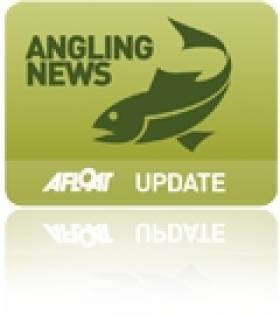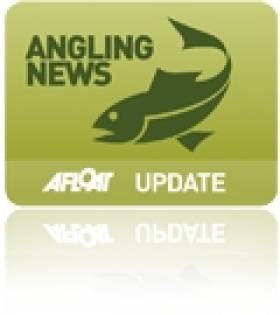Displaying items by tag: Sturgeon
Sturgeon Discovered in River Suir in Clonmel This Month
A distressed sturgeon was discovered in shallow water near Sir Thomas’s Bridge in the River Suir, near Clonmel in Co Tipperary on Thursday 1 June.
Inland Fisheries Ireland (IFI) says it was a likely escapee reared sturgeon of unknown origin. It weighed 22kg and was 147.5cm long.
Huge, but unsuccessful, efforts were made to revive the fish when discovered by a concerned and vigilant angler, who had immediately contacted IFI staff.
IFI authorised removal of the fish from the river. The sturgeon specimen is to be forensically examined by IFI research staff.
Wild sturgeon (Acipenser sturio) are a protected species under the EU Habitats Directive. Such fish are extremely rare visitors to Irish waters in modern times.
Anglers are being asked to notify IFI if any unusual fish species are observed.
NGOs have called for the restoration of wild sturgeon in Irish waters, as recently reported on Afloat.ie.
Two NGOs have called on the government to examine restoring sturgeon to Irish waters.
Also known as “dinosaur fish”, sturgeon can be traced back to the Jurassic period and were once “frequent” in these waters, the Irish Wildlife Trust (IWT) and the British Blue Marine Foundation state in a joint report.
“Before Irish independence, they were designated a “royal fish”, and any sturgeon caught was automatically the property of the British Crown,” the NGOs say.
“A legal review commissioned for this study found that under the Habitats Directive Ireland is obliged to examine the feasibility of reintroducing sturgeon,” they say.
Existing data show that suitable habitat exists for them, particularly in the rivers Shannon and Suir, they say.
The migratory fish spawn in freshwater, but spend most of their lives at sea.
“Sturgeon can therefore be an “umbrella species”, as in measures to restore their habitat will benefit a range of other species in the aquatic and marine environments,” they say.
The UK Sturgeon Conservation Strategy and Action Plan 2023-2033, recently published, complements pan-European efforts to restore the critically endangered sturgeon throughout its former range. Ireland must be part of this wider effort, they state.
IWT campaign officer Pádraic Fogarty said “we need to see a more concerted effort to reintroduce species to Ireland that have been driven to extinction”.
“We believe the sturgeon should be a priority, as many of the measures to restore its habitat, such as improving the status of rivers and the creation of marine protected areas, are already government commitments, “he says.
“ It’s also a magnificent animal that deserves to be brought back to Ireland in its own right,” Fogarty says.
Adrian Gahan of Blue Marine Foundation says said that surgeon once moved freely through the seas and rivers of Britain, Ireland and continental Europe.
“It is great to see conservation groups from across Europe come together to restore these ancient animals,” Gahan said.
“Nature does not recognise national borders so nor should our conservation efforts. Blue Marine Foundation is delighted to partner with The Irish Wildlife Trust on this important study,” he said.
COP26: Sturgeon Confirms Scotland 'Considering Joining' Alliance to End Oil & Gas Production
First Minister of Scotland, Nicola Sturgeon has confirmed the Scottish Government is “considering joining” an alliance of nations committed to ending drilling for oil and gas “in the not too distant future”.
But the First Minister has faced criticism after Scotland was not confirmed as a founding member of the Beyond Oil and Gas Alliance (BOGA) – formally announced by the Danish and Costa Rican governments at COP26.
Alongside Denmark and Costa Rica, the BOGA features France, Greenland, Quebec, Ireland, Sweden and Wales as core members and California and New Zealand as associate members.
The BOGA will seek a managed phase-out of oil and gas production to align with Paris Agreement goals but none of the members has a substantial production of oil and gas.
If Scotland does join the coalition, it would be the first nation to do so that heavily relies on oil and gas for its energy mix.
For much more The Herald reports.
As Afloat reported yesterday, Minister for Environment, Climate & Communications, Eamon Ryan confirmed Ireland’s new membership of Beyond Oil and Gas Alliance (BOGA) at COP26 held in Glasgow.
The signing by Ireland with this new alliance of governments aims to phase out oil and gas production in line with the existing Paris (COP21) agreement on climate change.
#sturgeon – Another rare sturgeon, this time the type which produces caviar for posh dinner tables, has been caught in the UK. The mystery is where they are coming from.
Anglers and commercial fishermen throughout the UK have been alerted for the second time in three months to watch out for rare sturgeon in their catches.
A 10-pound fish landed from the River Thames at Greenhithe, near Dartford, Kent, was a Siberian sturgeon, the type that provide caviar for posh dinner tables.
After being quickly weighed and photographed it was put back alive and unharmed into the water by local angler Peter Johnson. He had caught it on ragworm bait.
The catch was reported to French and German experts by the Institute of Fisheries Management (IFM). They confirmed it was a Siberian sturgeon (Acipenser baerii).
It was the second landed in the UK in exactly three months but some 250 miles from where the first was one hooked near Pembroke Dock, South Wales on August 2.
They are the first reported in British waters since 2004 when a monster more than eight feet long, was caught by a trawler also in South Wales, a mile and a half off Port Talbot.
Steve Colclough, chairman of the IFM's marine specialist section, said the fish could possibly be one lost from cages in the Gironde river in France some years ago during a caviar farming experiment.
"We think it is more likely to be an escapee from the UK pet trade. These exotic species are imported and this may show that some are now escaping into the wild.
Page 2
"The sturgeon caught in August was probably also a pet trade fugitive," Mr. Colclough added. "They are alien species and it is an offence to introduce them into the wild in the UK".
He reminded commercial fishermen and anglers to tell their local Inshore Fisheries and Conservation Authority or Cefas (01502 562 244) if they catch a sturgeon after first taking a photo and measurements and checking for any tag, and returning the fish alive to the water.
Mr. Colclough would also like to hear from them at [email protected] or 01634 327899."
He said a yellow tag on a sturgeon would show the fish had probably migrated from the Gironde river in France where they are now being bred and released.
These fish would normally stay in the Gironde until they were about ten years old when they might migrate to the open sea.
If they came to the UK they would most likely be caught in estuaries and still be juvenile fish. Normally they would live 50 or 60 years and grow up to three-metres (about 10 feet) long.
Caviar Anyone? That Just Might be a Sturgeon You’ve Hooked
#sturgeon – Sea anglers and commercial fishermen along coasts are being asked from today to watch out for one of the most unusual catches they may ever make - a sturgeon.
It is one of the most protected fish in the world. The eggs of the beluga species are served as caviar.
The sturgeon alert comes after one of two boys fishing at Hobbs Point, near Pembroke Dock, South Wales on August 2 hooked one about a metre long (3 feet).
"We are sure from the only photograph taken that it was a sturgeon and that it may be the forerunner of others arriving here. Where it came from is at present a mystery," said Steve Colclough of the Institute of Fisheries Management (IFM).
His records show that 133 sturgeon have been captured in the UK, the earliest in 1792. The most prolific year was 1972 when 30 were caught.
The last reported in UK waters was nine years ago when one 2.6 metres (8 feet 6 inches) long was caught in June 2004, also in South Wales by a trawler 2.4 kilometres (1.5 miles) off Port Talbot.
"It is illegal to retain sturgeon and anybody catching one should return it quickly unharmed and alive to the water and then report it." said Mr. Colclough who is chairman of the IFM marine section.
Page 2
"But before putting it back," Mr. Colclough added, "they should note as many facts as possible - its length, overall condition, signs of damage or disease, the data on any tag attached to it and take a good photo.
"A yellow tag would show the fish had probably migrated from the Gironde river in France where the European sturgeon is now being bred and released."
These fish would normally stay in the Gironde until they were about ten years old and they might then migrate to the open sea, Mr. Colclough added.
"If they came to the UK they would most likely be caught in estuaries and still be juvenile fish. Normally they would live 50 or 60 years and grow up to three-metres (about 10 feet) long"
Anglers should report any sturgeon caught to their local Inshore Fisheries and Conservation Authority (IFCA) or to the Centre for Environment, Fisheries and Aquaculture Science (Cefas) on 01502 562 244 at Lowestoft, or 01305 206 600 at Weymouth.
Mr. Colclough would also like to hear from them on 01634 686460 or by e-mail to [email protected]































































